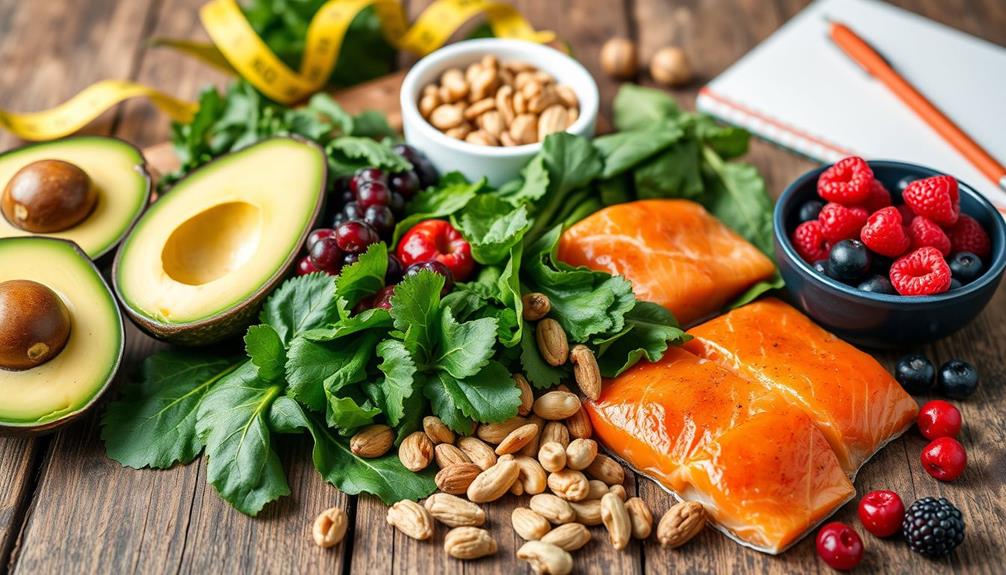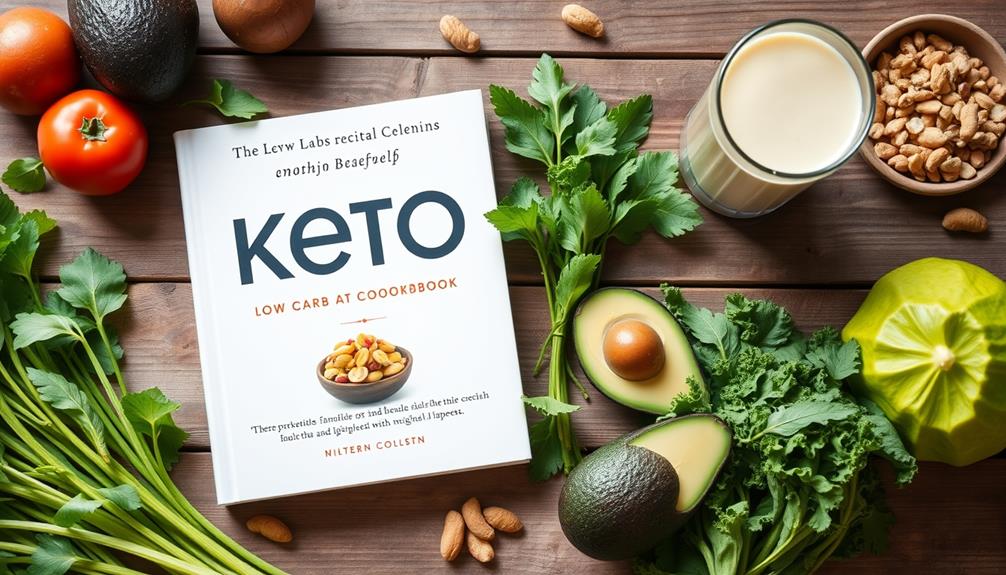To do the keto diet, you'll need to cut carbs greatly and boost your fat intake. Aim for about 70-80% of your daily calories from healthy fats, 15-25% from protein, and only 5-10% from carbohydrates. Focus on foods like avocados, nuts, and fatty meats while avoiding sugars, grains, and most fruits. You might experience initial symptoms known as "keto flu," so stay hydrated and balance your electrolytes. Tracking your meals can help you stay on course. As you adjust, there's plenty more to explore about maintaining it effectively, including tips and delicious recipes. In addition to weight loss, the ketogenic diet benefits may include improved blood sugar control, reduced inflammation, and increased mental clarity and focus. Many people also report feeling more sustained energy throughout the day. As you continue on this journey, be sure to listen to your body and make adjustments as needed to ensure you’re getting the most out of the ketogenic diet benefits. And remember, consistency is key when it comes to seeing long-term results.
Key Takeaways
- Adopt a high-fat, low-carb diet consisting of 70% fats, 20% proteins, and 10% carbohydrates to enter ketosis.
- Limit daily carbohydrate intake to 20-50 grams to facilitate fat burning for energy.
- Focus on whole foods like avocados, nuts, and leafy greens to maintain nutrient density.
- Stay hydrated and balance electrolytes to mitigate keto flu symptoms during the transition.
- Monitor your progress with a food journal and tools to check ketone levels regularly.
Understanding the Keto Diet

When it comes to understanding the Keto Diet, it's essential to grasp its core principles. This high-fat, low-carb diet typically consists of around 70% fat, 20% protein, and only 10% carbohydrates. By drastically reducing your carbohydrate intake to about 20-50 grams per day, you'll help your body reach ketosis, a metabolic state where it burns fat for fuel instead of glucose.
Maintaining hydration is vital during this shift, as it plays a key role in optimizing health while following a ketogenic approach, which is fundamental for overall well-being hydration as a key factor.
The ketogenic diet was initially developed to manage epilepsy in children, but it's now widely embraced for its weight loss benefits and improved metabolic health, particularly for those with type 2 diabetes. Unlike other low-carb diets, such as Atkins or Paleo, the Keto Diet emphasizes a much higher fat intake, focusing on healthy fats like avocados, nuts, and olive oil.
As you move into this way of eating, be prepared for the possibility of experiencing the "keto flu," which can manifest as fatigue, headache, or digestive issues. These symptoms generally resolve within a few weeks, allowing you to pursue your weight loss goals more effectively.
Embracing these core principles will set you on the right path for success with the keto diet.
How Ketosis Works

Ketosis is when your body shifts from burning glucose for energy to using fat, producing ketones in the process.
To get there, you need to cut back on carbs considerably and stick to a high-fat diet.
This dietary change can also be seen as a form of budgeting your macronutrients, where you prioritize fat intake while limiting carbohydrates.
Understanding how to shift into and maintain ketosis is key to reaping its benefits.
Ketosis Definition and Benefits
Stepping into ketosis means your body shifts gears, moving from burning glucose to utilizing ketone bodies derived from fat. This metabolic state occurs when you consume less than 50 grams of carbohydrates daily, prompting your liver to convert fatty acids into ketones.
Benefits of Ketosis
| Benefit | Description |
|---|---|
| Improved Blood Sugar | Helps stabilize blood sugar levels, reducing spikes. |
| Enhanced Mental Clarity | Many report sharper focus and cognitive function. |
| Increased Fat Oxidation | Your body efficiently burns fat for energy. |
| Appetite Suppression | You may feel less hungry, aiding weight loss. |
| Weight Loss | Reduced caloric intake contributes to fat loss. |
While entering ketosis, you might experience the "keto flu," a temporary phase with symptoms like fatigue and irritability as your body adjusts. However, once established, ketosis can lead to significant health benefits. By utilizing ketone bodies, you not only enhance your energy levels but also promote effective fat loss, making this diet an attractive option for many seeking to improve their metabolic health.
Transitioning to Ketosis
Achieving ketosis involves a significant adjustment in your diet, primarily focused on drastically cutting carbohydrate intake to between 20-50 grams per day. This reduction forces your body to change from using glucose as its primary energy source to burning fat for fuel.
During the first 2-7 days of moving to ketosis, you may experience symptoms often referred to as the "keto flu," as your body adapts to utilizing ketone bodies, which are produced from fat metabolism. It's vital to protect your investments during this change, just as you'd manage risks in a Bitcoin IRA by being informed and strategic.
As your liver converts fatty acids into these ketone bodies, you'll notice enhanced mental clarity and increased energy levels.
However, it's important to monitor your protein intake during this period. Consuming too much protein can trigger gluconeogenesis, where your body converts protein into glucose, making it harder to maintain ketosis.
Maintaining Ketosis Effectively
Maintaining ketosis requires a careful balance of macronutrients to guarantee your body continues to burn fat for energy. To effectively sustain this metabolic state, you need to keep your carbohydrate intake low, usually between 20-50 grams per day.
Your liver converts stored fats into ketone bodies, which are essential for fueling your brain and other organs. Additionally, it's important to reflect on the impact of various foods on your overall health, as some high-fat options may not support your nutritional needs effectively.
Focusing on whole, nutrient-dense foods can be beneficial natural remedies alongside conventional medications.
Here are key points to remember for maintaining ketosis:
- Monitor your macronutrient ratios: Aim for 70-80% of calories from fats, 15-25% from proteins, and only 5-10% from carbohydrates.
- Be cautious with protein consumption; excess protein can convert to glucose via gluconeogenesis, potentially hindering ketosis.
- Stay hydrated and ensure adequate electrolyte intake (sodium, potassium, magnesium) to combat the keto flu and support bodily functions.
- Make gradual dietary changes to avoid overwhelming your system, allowing your body to adapt smoothly.
Types of Keto Diets
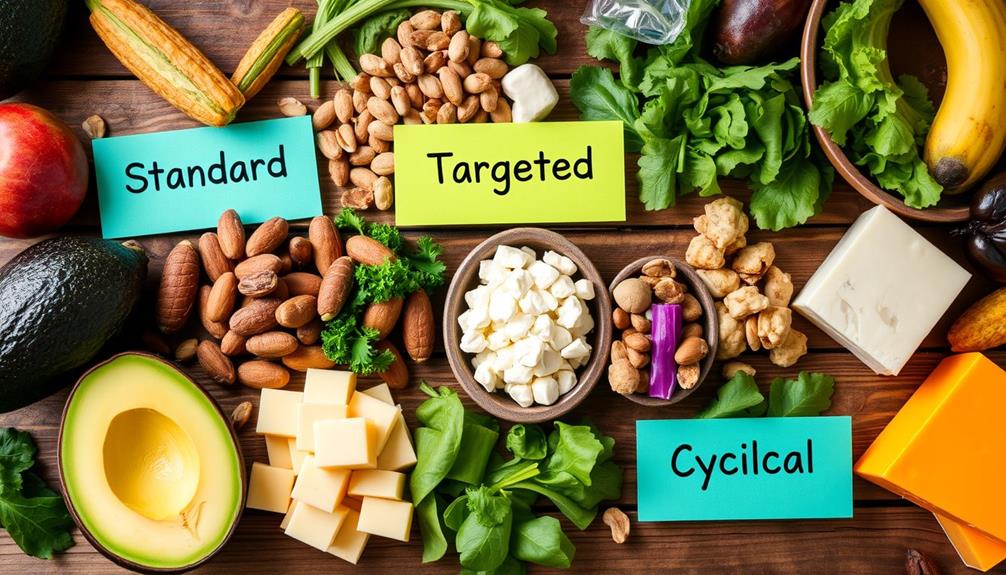
When exploring types of keto diets, you'll come across the Standard Ketogenic Diet (SKD) and the Targeted Ketogenic Diet (TKD).
SKD focuses on strict carb limits to achieve ketosis, while TKD allows you to consume carbs around your workouts for extra energy.
Understanding these options can help you choose the best approach for your lifestyle and goals.
Standard Ketogenic Diet
Exploring the Standard Ketogenic Diet (SKD) reveals its straightforward approach to achieving ketosis for effective fat burning. This diet is well-researched and widely recommended for weight loss and health improvement.
By limiting your carbohydrate intake to about 20-50 grams per day, you can shift your body into ketosis, allowing it to burn fat for energy instead of carbs. Additionally, incorporating nutrient-rich foods, such as leafy greens and avocados, enhances the diet's health benefits while providing essential vitamins and minerals, which can help mitigate potential nutrient deficiencies often associated with restrictive diets like juice diets.
Here's what you can expect from the SKD:
- Macronutrient Ratio: Typically, your daily diet will consist of about 70% fat, 25% protein, and only 5% carbohydrates.
- Rapid Initial Weight Loss: You might experience quick weight loss initially, primarily due to water weight.
- Gradual Fat Loss: As you adapt, expect to see gradual fat loss as your body becomes efficient at utilizing fat for energy.
- Simplicity: Unlike other keto variations, SKD doesn't involve high-carb days or targeted carb intake around workouts, making it easier to stick to.
Targeted Ketogenic Diet
Are you looking for a way to combine the benefits of ketosis with the energy needed for intense workouts? The Targeted Ketogenic Diet (TKD) allows you to consume extra carbohydrates around your workouts. By adding 20-50 grams of carbs before exercising, you can provide your body with quick energy for high-intensity training while still reaping the fat-burning benefits of ketosis.
Here's a quick overview:
| Aspect | Targeted Ketogenic Diet | Benefits |
|---|---|---|
| Carb Timing | 30-60 minutes pre-workout | Optimizes energy levels |
| Daily Carb Intake | Flexible option | Supports workout performance |
| Primary Fuel Source | Fat | Maintains fat-burning state |
| Ideal For | Athletes & bodybuilders | Enhances recovery and performance |
| Main Goal | Energy for workouts | Sustaining ketosis throughout the day |
With TKD, you're not stuck with strict low-carb rules all day. Instead, you can strategically time your carb intake to boost your performance without derailing your ketosis. This approach helps you enjoy the best of both worlds: enhanced energy levels for workouts and the fat-burning benefits of a ketogenic lifestyle.
Foods to Include
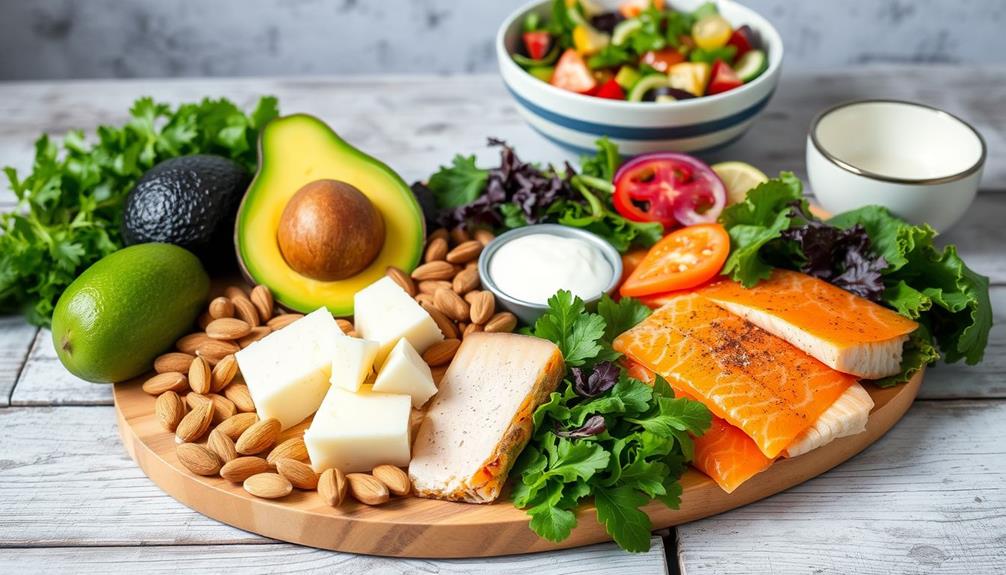
A successful ketogenic diet revolves around incorporating a variety of high-fat foods while keeping carbohydrates to a minimum.
To effectively follow this diet, focus on foods that contribute to your daily caloric intake, with approximately 70% coming from healthy fats, 20% from moderate protein, and only 5% from carbohydrates.
Including healthy fats can also be complemented by using essential oils for overall wellness, such as essential oils for toothache relief to help manage discomfort during dietary changes.
Here are some essential food categories to include:
- High-fat foods: Avocados, nuts, seeds, olive oil, and fatty cuts of meat.
- Low-carb vegetables: Leafy greens, broccoli, cauliflower, and zucchini, which are vital for vitamins and minerals.
- Protein sources: Eggs, fatty fish like salmon, and grass-fed dairy products such as cheese and yogurt.
- Low-sugar fruits: Berries like strawberries and raspberries, consumed in moderation.
Foods to Avoid
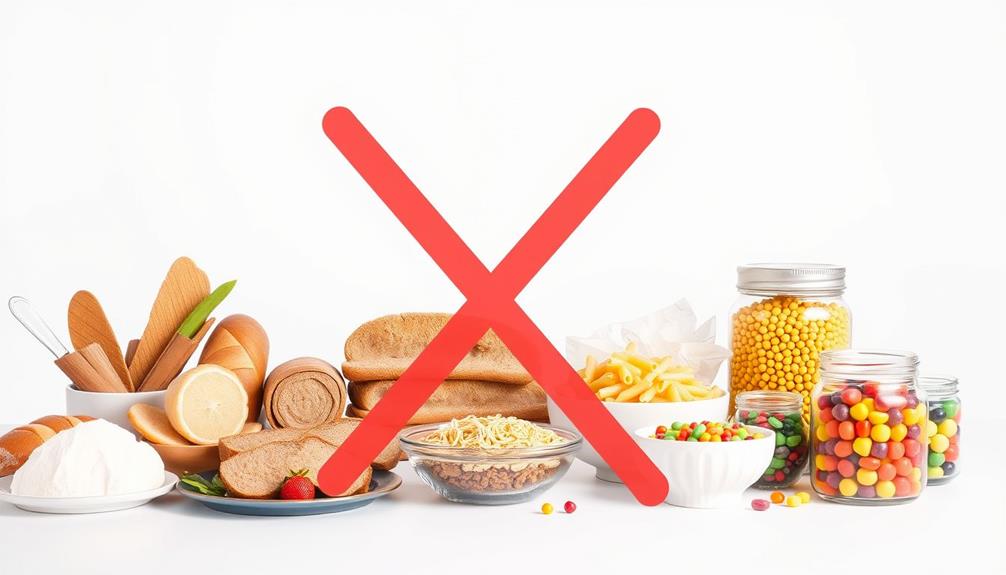
To successfully maintain a ketogenic diet, it's crucial to steer clear of certain foods that can sabotage your efforts. First and foremost, avoid sugary items like soda, fruit juice, cakes, and candies. These foods can greatly increase your carbohydrate intake and hinder ketosis, similar to how individuals with BPD experience intense emotional responses that can derail their stability.
Grains such as wheat, rice, and pasta are also high in carb content, often exceeding the daily limit of 20-50 grams necessary for maintaining ketosis.
When it comes to fruits, most should be off-limits. While small portions of berries are acceptable, other fruits contain higher amounts of natural sugars that can disrupt your low-carb goals. Similarly, starchy vegetables like potatoes, carrots, and corn are rich in carbohydrates and can prevent your body from entering or maintaining ketosis.
Lastly, processed foods and snacks often contain hidden sugars and carbs, making them risky for your ketogenic diet. By eliminating these foods to avoid, you'll make it easier to adhere to the strict macronutrient ratios needed for success.
Staying diligent about your choices will help you achieve your keto goals more effectively.
Meal Planning Strategies
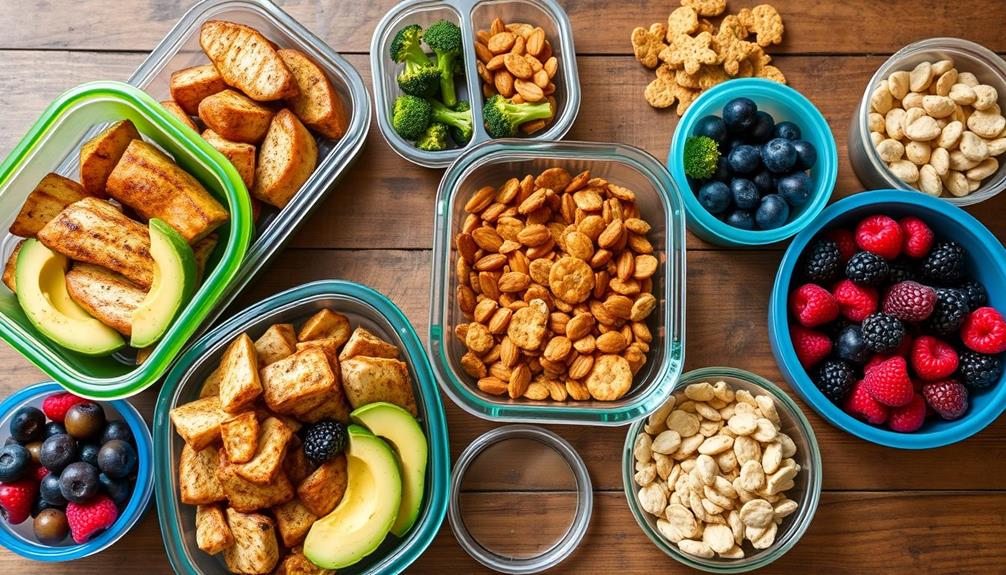
Effective meal planning is key for managing the ketogenic diet successfully. By planning your meals in advance, you can guarantee you're incorporating high-fat foods while keeping your carbohydrate intake between 20-50 grams per day. This helps you achieve ketosis and maintain the ketogenic macronutrient ratios of approximately 70% fat, 20% protein, and 10% carbs.
Additionally, understanding the impact of different ingredients on your overall diet can enhance your meal choices, just as various brewing methods affect caffeine content in coffee.
Here are some strategies to enhance your meal planning:
- Create a weekly menu featuring high-fat foods like avocados, nuts, and fatty fish.
- Utilize meal prep techniques, cooking large batches of keto recipes and portioning meals for easy access throughout the week.
- Prepare keto-friendly snacks, such as cheese, olives, or nut butter, to curb hunger between meals.
- Make use of online resources, like keto recipe websites and meal planning apps, to discover new dishes and maintain variety in your diet.
Managing Side Effects
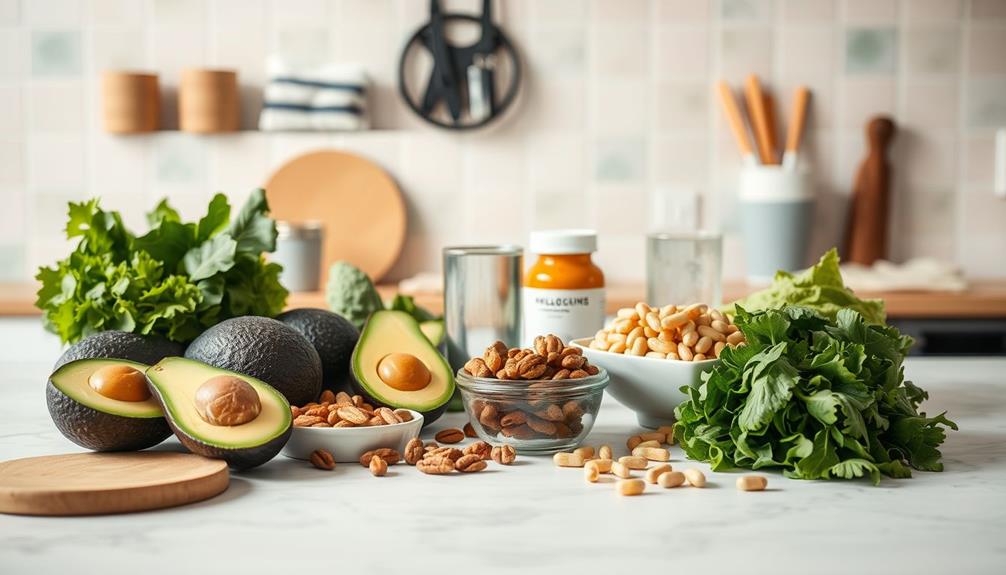
When you start the ketogenic diet, you might experience symptoms commonly known as "keto flu," like fatigue and headaches.
To ease these effects, staying hydrated and balancing your electrolytes is essential. Incorporating gentle stretching before bedtime can also help with muscle relaxation and ease discomfort during this shift.
Additionally, making gradual changes to your carbohydrate intake can help your body adjust more smoothly to this new way of eating.
For more tips on managing discomfort, consider yoga for back pain.
Common Keto Flu Symptoms
Many people experience a range of symptoms commonly referred to as "keto flu" during the initial days of starting a ketogenic diet. As your body shifts from burning carbohydrates to fat for fuel, you might feel a bit off. Common symptoms include:
- Fatigue
- Headache
- Nausea
- Dizziness
You may also notice irritability and gastrointestinal issues like constipation or diarrhea as your diet changes. These symptoms stem from electrolyte imbalances and the body losing water during this adjustment phase.
Understanding the importance of staying hydrated is essential, especially since these symptoms can be exacerbated by dehydration and electrolyte shifts, which are similar to the financial considerations for assisted living expenses.
While it can be uncomfortable, remember that the keto flu is temporary and usually resolves within 3-4 days.
To help mitigate these effects, focus on staying hydrated and consider increasing your intake of sodium, potassium, and magnesium. This can make a significant difference in how you feel as you adjust.
If you experience severe symptoms that persist beyond the adaptation period, consulting a healthcare professional is advisable.
Keep in mind that while uncomfortable, the keto flu is just a passing phase on your journey to a healthier lifestyle.
Hydration and Electrolyte Balance
Staying hydrated and maintaining electrolyte balance is essential while on the keto diet. As your body enters ketosis, it excretes more water and electrolytes, which means you need to increase your fluid intake. Aiming for at least 2-3 liters of water daily is a good rule of thumb, but adjust based on your activity levels and body size.
To combat symptoms of "keto flu," such as fatigue, headaches, and muscle cramps, focus on getting enough sodium, potassium, and magnesium. Incorporate electrolyte-rich foods like avocados, leafy greens, and nuts into your meals. These foods not only help replenish lost electrolytes but also support your overall health during this dietary shift.
Keep an eye on your hydration levels and be mindful of how you feel. If you experience symptoms, consider increasing your water intake and adjusting your electrolyte consumption. This proactive approach can lead to a smoother adaptation to the ketogenic diet, allowing you to enjoy its benefits without the discomfort of imbalance.
Gradual Dietary Transition Tips
Changing into the keto diet can feel overwhelming, but a gradual approach can ease the process and minimize side effects. By slowly adjusting your carbohydrate intake, you can help your body shift into ketosis more comfortably. Here are some tips to manage this gradual shift:
- Start by cutting your carbohydrate intake by 50% for a few days, then progressively reduce it to 20-30 grams daily.
- Incorporate high-fat foods gradually, aiming for them to comprise 70-80% of your daily caloric intake in the long run.
- Focus on non-starchy vegetables to maintain fiber intake and support gut health.
- Keep track of your dietary adherence and individual reactions by maintaining a food diary.
During the first week, pay attention to your hydration and increase your electrolyte intake, especially sodium, potassium, and magnesium, to mitigate "keto flu" symptoms like fatigue and headaches.
Monitor how your body responds, as individual reactions can vary. By following these steps, you can make your shift to the keto diet smoother and more sustainable.
Monitoring Progress
To effectively monitor your progress on the keto diet, it's essential to track key metrics that reveal how well you're adhering to the plan.
Start by keeping a food journal to log your meals and snacks, ensuring you meet the macronutrient ratios of around 70% fat, 20% protein, and 10% carbs. Pay particular attention to your carbohydrate intake, aiming for a limit of 20-50 grams daily to maintain ketosis.
Regularly check your ketone levels using urine strips, blood meters, or breath analyzers. This will help you confirm whether your body is in a state of ketosis.
Weigh yourself weekly to gauge weight loss progress, but remember that initial changes might reflect water loss rather than fat loss.
Additionally, take note of any changes in your energy levels, mental clarity, and overall well-being.
These qualitative indicators of success can be just as important as numerical values, giving you a more holistic view of how the ketogenic diet is impacting your life.
Long-term Considerations

Monitoring your progress on the keto diet can help you understand how well it fits your lifestyle, but long-term adherence brings its own set of challenges. Many people find the restrictive nature of keto tough to maintain, often reverting to old eating habits and experiencing weight regain.
To guarantee lasting success, consider the following:
- Keep track of your macronutrient intake; excess protein can convert to glucose, which hinders ketosis.
- Watch for potential nutrient deficiencies due to the limited food variety; incorporate nutrient-dense, low-carb options and consider supplements.
- Schedule regular check-ups with healthcare professionals to assess your cholesterol levels and overall health, as individual responses to keto vary.
- Shift to a more balanced dietary approach after your initial keto phase to support long-term weight loss and health and wellness.
Resources for Support

Finding the right resources can make a significant difference in your keto journey. Start by tapping into expert insights from reputable sources like the Cleveland Clinic and Mayo Clinic. These platforms offer valuable guidelines to help you navigate dietary changes effectively.
For thorough management tips, check out Johns Hopkins Medicine, which provides detailed meal planning strategies and highlights potential health benefits of the ketogenic diet.
To ease your adjustment, visit Familydoctor.org for practical advice on identifying keto-friendly foods and meal prep techniques that promote adherence. Connecting with others on the same path can boost your motivation, so consider joining online support groups and community forums dedicated to the keto diet. Sharing personal experiences and recipes can enrich your journey.
Additionally, utilize various health tools and calculators available online for tracking progress and macronutrient intake. Keeping tabs on your dietary adjustments will help you stay committed and make informed choices.
Frequently Asked Questions
What Is the Correct Way to Do a Keto?
To do keto correctly, you'll need to limit carbs, prioritize high-fat foods, and balance your protein intake. Stay hydrated, plan meals ahead, and monitor your body's response to guarantee you maintain ketosis effectively.
How Do I Start Going on Keto?
Did you know that about 20% of people who try low-carb diets find it challenging to stick with them? To start, cut carbs considerably, focus on healthy fats, and prepare meals in advance for success.
What Are the Basic Rules of a Keto Diet?
The basic rules of a keto diet involve drastically reducing carbs to 20-50 grams daily. Focus on high-fat foods, monitor protein intake, and guarantee hydration and electrolyte balance to support your body's shift to ketosis.
What Foods Do You Eat on a Keto Diet?
Imagine a rich, velvety chocolate cake; instead, you'll savor creamy avocados, crunchy nuts, and juicy meats. You'll delight in leafy greens and occasional berries, while steering clear of sugary temptations that derail your journey.
Conclusion
In your journey with the keto diet, remember that "Rome wasn't built in a day." Embrace the changes gradually, and be patient with yourself as you adapt. By understanding how ketosis works and making informed food choices, you'll set yourself up for success. Stay mindful of your progress and any side effects, and don't hesitate to seek support. With dedication and the right approach, you can achieve your health goals and enjoy the benefits of a keto lifestyle. As you navigate the keto diet, familiarize yourself with the keto diet basics, such as maintaining low-carb intake and increasing healthy fat consumption. Remember to stay hydrated and prioritize getting enough electrolytes to support your body’s adjustment to ketosis. With dedication to learning and implementing these fundamentals, you’ll be well on your way to achieving success with the keto diet and experiencing the positive impact it can have on your overall health and wellbeing.
